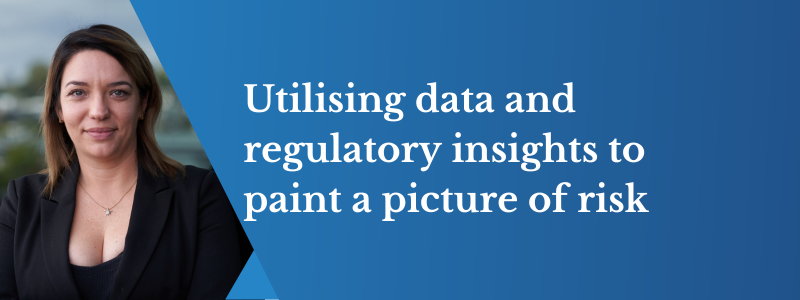The new regulation – painting a picture of risk
March 6, 2024 | Aged Care Management

By Katie Airey, Quality, Risk and Compliance Lead
The Aged Care Quality and Safety Commission (ACQSC) will oversee the performance of aged care providers through risk-based monitoring. The Commission’s risk monitoring approach has commenced, with audits underway to ensure compliance to regulatory changes that have come into effect.
Under the new Regulatory model, risk-based monitoring will rely on data and regulatory insights to identify potential risks or issues that necessitate additional scrutiny and, if needed, a response in relation to identified risks.
Painting a picture of Risk
Under the proposed new regulatory model for aged care, data and intelligence will be collected from multiple sources, including;
- Provider notifications and reporting i.e QFRs, ACFRs (care time / dollars going into care)
- AN-ACC Classes & Make up (Compounding Factors etc.)
- QI indicators
- Resident Survey Data
- Accreditation audit outcomes and history
- Food, Nutrition and Dining Hotline
- Formal Complaints
- Serious Incident Response Scheme (SIRS)
- Star Rating trends over time
- Provider registration category
- Worker Screening – Banning Orders
- Compliance with Financial & Prudential Standards
- the Department and other regulators (such as the NDIS Quality and Safeguards Commission).
The Commission (and the Department) will use the above listed data, and related information along with technology capabilities to form a picture of risk for each provider. This will then inform the ACQSC through priority indicators which suggest older people may be at serious risk of harm and will trigger a risk proportionate regulatory response.
Risk-based monitoring
The ACQSC and the DoHAC will use data intelligence to determine broader risks in the aged care sector, with the aim to take a targeted approach in identifying risks related to poor care prior and harm being caused to older people. The ACQSC and DoHAC will identify trends across providers data. These trends will be used to determine if the safety and quality of care provided demonstrates system-wide failures in specific areas. It is expected that these data trends will also identify exploitative behaviour, potential prudential risks and risks associated with provider exits from the sector.
The risk-based monitoring approach will encompass a range of monitoring methodologies including;
- site based monitoring
- desk based audits
- announced, or unannounced visits
The new regulatory model will allow the ACQSC to have the power to request at anytime;
- Documents & information
- Undertake site visits
- Interview older people, workers & others
These monitoring activities will be supported by increased powers for the ACQSC, which are expected to allow them to enter and remain in a premises at any time without warrant or consent. In order to allow them to exercise their monitoring and investigative powers. This information will be used to determine if a provider and its workers are meeting the new provider registration requirements applicable to their assigned category, along with ensuring the rights of older people are upheld.
In addition, the ACQSC will have access to AN-ACC claim data to enhance their risk-based monitoring. This data will be used to ensure each provider is responding to changes in their consumer case mix and are aligning their workforce strategies to their care obligation and minimum care minute targets.
Response to recognised risk
The ACQSC have been clear in their communication that they will take a risk proportionate response to non-compliance that aligns with the principles of natural justice and procedural fairness.
The new Aged Care Act is expected to include two key notices; a requirement for Action Notice and a Compliance Notice. These notices will be used by the ACQSC to enforce actions on providers where non-compliance or risk of non-compliance has been identified.
There will also be an escalation pathway, where failure to comply with these notices will differ from current arrangement. The change will include;
- Failure to comply with a Requirement for action Notice may lead to a Compliance Notice, further monitoring, investigation by ACQSC or an enforcement action.
- Failure to comply with a Compliance Notice could have more significant consequences, with a civil penalty expected to be available (similar to where a provider fails to comply with a NDIS compliance notice)
Would you like to learn how you can better manage your organisation’s risk in 2024 and beyond? Register now for our free training session as we share key insights on the upcoming regulatory and legislative changes. The session will cover what the new Aged Care Act, new Regulatory Model, and Strengthened Quality Standards will bring in 2024 and beyond.


